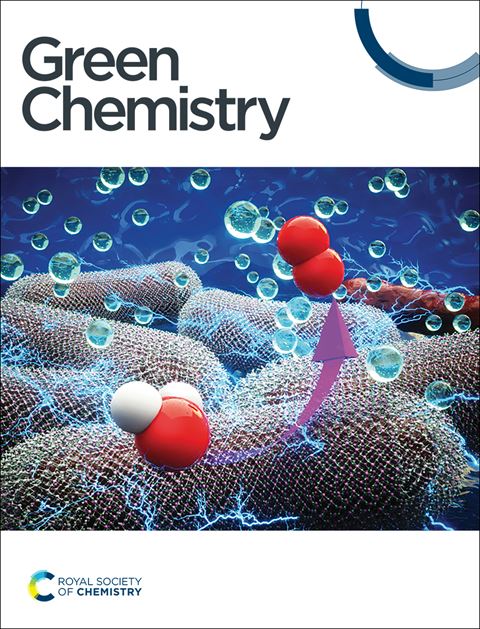一种由genipin交联的自粘面筋蛋白涂层,用于抑制恶劣环境下的微塑料脱落
IF 9.2
1区 化学
Q1 CHEMISTRY, MULTIDISCIPLINARY
引用次数: 0
摘要
塑料包装的大规模应用引起了人们对微塑料(MPs)产生的关注。食品中MPs的存在已被越来越多的报道,而塑料包装是主要来源之一。然而,很少有研究关注抑制MPs脱落的策略。本文以豆浆皮为灵感,开发了一种简单、绿色、耐用的涂层,用于抑制食品级塑料在七个恶劣模拟环境(考虑热、酸、碱、盐、油五种因素)下MP的脱落。该涂层经三(2-羧基乙基)膦处理后,通过谷蛋白的相变形成,在温和的条件下自发粘附在任何塑料表面。为了改善其物理性能,用皂角素作为交联涂层。交联涂层的性能改善表现在以下几个方面:(1)接触角由84.7°增加到96.1°;(2)密封性改善;(3)粗糙度由0.59 μm降至0.31 μm;(4)弹性模量由19.85 GPa提高到30.87 GPa;(5)气屏障渗透率提高24.46%;(6) MPs脱落丰度降低61.14%。值得注意的是,在任何恶劣条件下,交联涂层对MP脱落的抑制率都在92%到98%之间。涂层后,荧光显微镜和微拉曼显微镜下均未观察到尺寸超过100 μm的MPs。此外,利用傅里叶变换红外光谱和x射线光电子能谱研究了genipin在涂层上的共价交联机理。此外,用细胞增殖实验证明了涂层的安全性。总的来说,这项工作为MPs的控制提供了新的见解,激励研究人员更多地关注前端来源并设计新材料来抵御MPs对人类健康的威胁。本文章由计算机程序翻译,如有差异,请以英文原文为准。

A self-adhesive glutenin-based coating cross-linked by genipin for suppressing microplastic shedding in harsh environments†
The large-scale application of plastic packaging has raised concerns on the generation of microplastics (MPs). The presence of MPs in food has been increasingly reported, and plastic packaging is one of the main sources. However, few studies have focused on strategies to inhibit shedding of MPs. Herein, a simple, green, and durable coating, which was inspired from soybean milk skin, was developed to suppress MP shedding from food-grade plastics in seven harsh simulation environments (considering the five factors of heat, acid, alkali, salt, and oil). This coating was formed via the phase transition of glutenin after treatment with tris(2-carboxyethyl)phosphine, and it spontaneously adhered to any plastic surfaces under mild conditions. To improve its physical properties, genipin was used as a cross-linking coating. The performance of the cross-linked coating improved in the following aspects: (1) increase in its contact angle from 84.7° to 96.1°; (2) improvement in its tightness; (3) reduction in its roughness from 0.59 μm to 0.31 μm; (4) improvement in its elastic modulus from 19.85 GPa to 30.87 GPa; (5) improvement in its gas barrier permeance by 24.46%; and (6) and decrease in the shedding abundance of MPs by 61.14%. Notably, the inhibition rate of the cross-linked coating on MP shedding under any harsh conditions ranged from 92% to 98%. After coating, MPs with sizes exceeding 100 μm were not observed through fluorescence and micro-Raman microscopies. Moreover, the covalent crosslinking mechanism of genipin on the coating was investigated using Fourier transform infrared and X-ray photoelectron spectroscopies. Furthermore, cell proliferation was used to demonstrate the safety of the coating. Overall, this work provides new insights into the control of MPs, inspiring researchers to focus more on the front-end source and design new materials to defend against the threat of MPs to human health.
求助全文
通过发布文献求助,成功后即可免费获取论文全文。
去求助
来源期刊

Green Chemistry
化学-化学综合
CiteScore
16.10
自引率
7.10%
发文量
677
审稿时长
1.4 months
期刊介绍:
Green Chemistry is a journal that provides a unique forum for the publication of innovative research on the development of alternative green and sustainable technologies. The scope of Green Chemistry is based on the definition proposed by Anastas and Warner (Green Chemistry: Theory and Practice, P T Anastas and J C Warner, Oxford University Press, Oxford, 1998), which defines green chemistry as the utilisation of a set of principles that reduces or eliminates the use or generation of hazardous substances in the design, manufacture and application of chemical products. Green Chemistry aims to reduce the environmental impact of the chemical enterprise by developing a technology base that is inherently non-toxic to living things and the environment. The journal welcomes submissions on all aspects of research relating to this endeavor and publishes original and significant cutting-edge research that is likely to be of wide general appeal. For a work to be published, it must present a significant advance in green chemistry, including a comparison with existing methods and a demonstration of advantages over those methods.
 求助内容:
求助内容: 应助结果提醒方式:
应助结果提醒方式:


